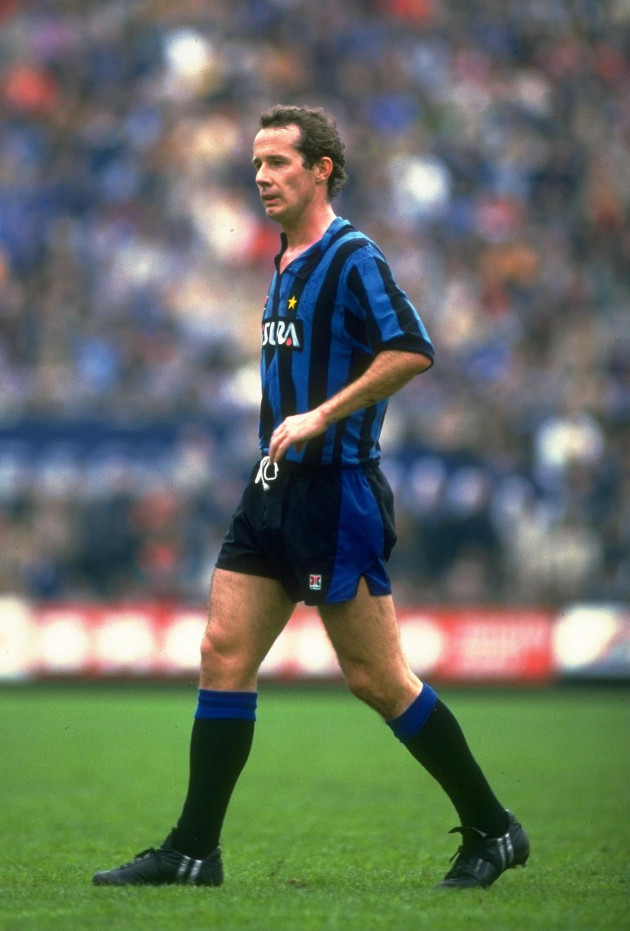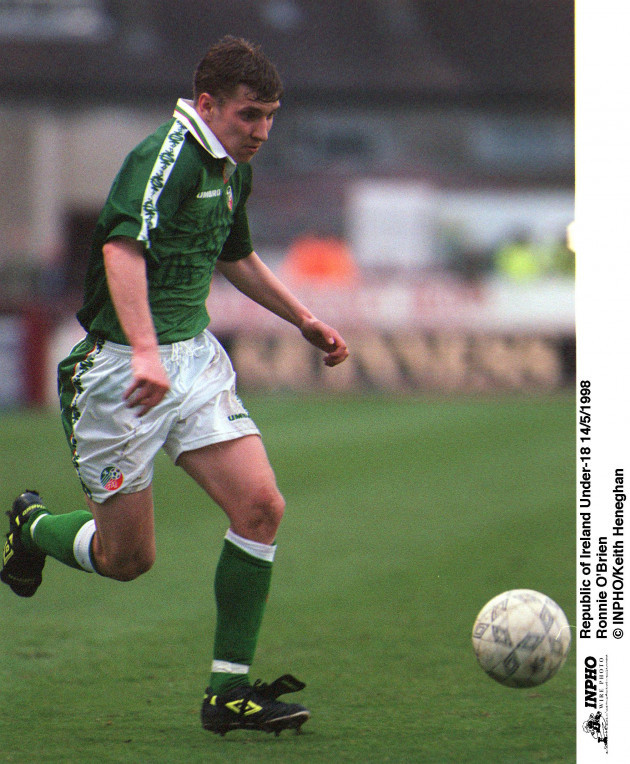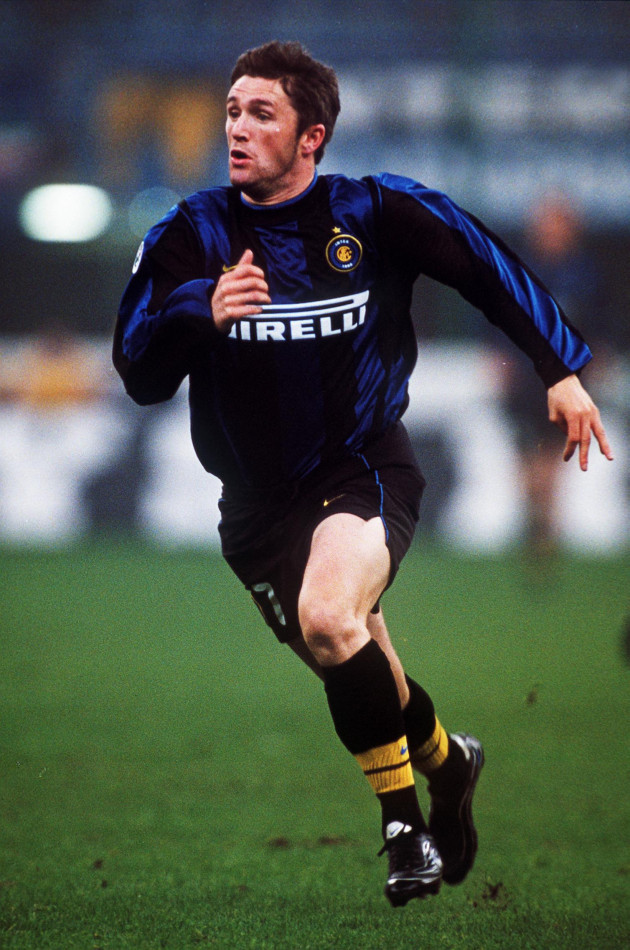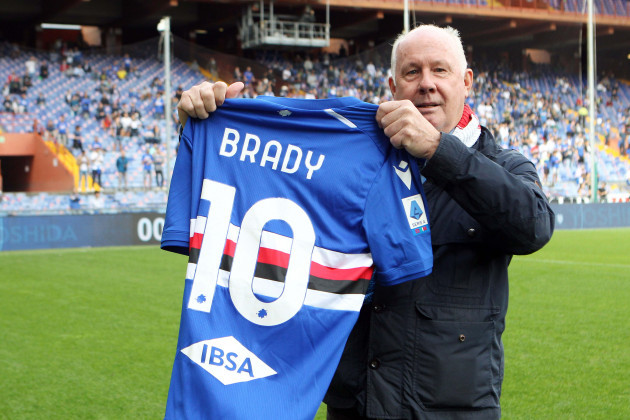JOHN FOOT IS the author of the definitive book on Italian football, Calcio, and it is in that book that he states his belief that only four, male English-speaking players have been unqualified successes in Italy: John Charles, Gerry Hitchens, Eddie Firmani, and of course, Liam Brady.
Brady’s was by far the most significant Irish impact in Serie A, but by no means the only one. There is now a burgeoning Irish contingent in Italy: Aaron Connolly has this week joined Venezia on loan, following a path already tread by youngsters Kevin Zefi (Inter Milan), Cathal Heffernan (AC Milan), James Abankwah (Udinese), and Festy Ebosele (also Udinese.)
Nor was Brady the first Irishman to appear in Serie A. That honour apparently belongs to Matts Kunding, a player on whom so little information survives that there are ongoing doubts as to whether he was simply invented. But certain dusty record books in Turin record him as among the very first Irish footballers to play outside of the UK, lining out Torino in 1909 and then moving to Juventus a year later.
It was after the wars by the time another Irishman graced the Italian leagues: Armagh’s Paddy Sloan, who initially joined Manchester United before making his way to Arsenal. He then moved to Sheffield United, who then sold him to AC Milan in 1948 for £10,000.
Sloan scored nine goals in 30 games in his one season at Milan, where his work-ethic and tenacity earned him the nickname ‘The Tiger.’ He also had a creative flourish, wearing white anklets on the pitch to allow his team-mates find him more easily. He helped Milan finish second in Serie A, behind the brilliant champions known as Grande Torino. This was the club’s final triumph before the Superega air tragedy, in which the squad were killed in a plane crash on the way back from a friendly game against Benfica. Sloan moved to Torino in the disaster’s aftermath but only briefly, joining Udinese and then Brescia for what proved to be a three-year stint in Italy. He was highly-regarded and twice voted inside-forward of the year, but returned to England in 1951 as he wanted to be closer to his wife and three daughters. He joined Norwich, who signed him when their manager flew to Brescia with a suitcase of £4,000 in cash, having been given dispensation to pay in pounds rather than lire.
Paddy Sloan (right) the first Irishman to play in Serie A. Pictured when at AC Milan. Paddy also had spells with Torino, Udinese and Brescia. #WildGeese pic.twitter.com/eFA8Ac4kgk
— Irish Football Pics (@irish_pics) September 28, 2018
He made just six appearances for Norwich before joining Peterborough. Upon his signing, the Peterborough Standard newspaper described Sloan as “one of the most controversial figures in modern football”, without ever truly explaining why. His supposed notoriety seemed to stem from his reverence for money. He was paid £1500 in his final year at Brescia and told a Derry newspaper not to print that fact, as “footballers are not supposed to make a lot of money.”
Sloan’s first year in Italy saw him join all other professional players in threatening strike action if the federation did not loosen their laws around foreign players, and increase the number of non-Italians permitted in a squad from three to four. It didn’t quite work and in 1965, Serie A banned all foreign players from the league. That wasn’t lifted until 1980, at which point Juventus moved swiftly to sign Liam Brady from Arsenal.
Brady won the PFA Players of the Year award a year earlier and helped Arsenal knock Juve out of the Cup Winners’ Cup, but he didn’t initially expect to move to Turin, as he told Eamon Dunphy on the Stand podcast a few years ago. Brady was making a relatively meagre £200 a week at Arsenal and had seen Kevin Keegan leave Liverpool for Hamburg two years earlier, so decided to widen his market. He initially expected to join Bayern Munich, until left-back Paul Breitner lobbied the club to remould him as a midfielder and took what would have been Brady’s spot.
Instead he joined Giovanni Trapattoni’s Juventus, winning back-to-back championships, famously scoring the penalty that sealed the second of those scudetti in 1982, just weeks after being told he was on the way out of the club to facilitate the arrival of Michel Platini. Brady stayed in Italy, joining a newly-promoted Sampdoria side that had signed Roberto Mancini a fortnight earlier.
His first game for Samp was, naturally, against Juventus: a 1-0 win which Brady greatly enjoyed, which set up a seventh-placed finish. They went one better in the league the following season, at which point Brady left for Inter Milan, amid interest from AC Milan and Roma.
There he belatedly got the chance to play alongside Karl-Heinz Rummenigge but Inter collapsed with the Serie A title in view, losing four of their final eight games to finish third, with the title won by Hellas Verona for the first time in their history. This Inter iteration were nearly-men: they were knocked out of the semi-finals of the Italian Cup and then Uefa Cup, losing the latter to Real Madrid on penalties.
“The regrets I have are that we didn’t win the league with Inter when we had the team to do it”, lamented Brady to Michael Walker in the book, Green Shoots. “Rummenigge, Altobelli, Ferri, Zenga, Pepe Baresi, Bergomi. We had a real team.”
The following season was Brady’s last at Inter. Again they were knocked out of the semi-final stage in Europe by Real Madrid, and again they didn’t win the title, though Brady did equalise in a league game against Napoli, for whom Diego Maradona scored the opening goal. Asif Kapadia, who directed a fabulous documentary on Maradona’s time in Naples, argues that these years in Serie A were the most competitive league seasons in the history of modern football: like the Premier League today, Italy drew all of the world’s best talent but unlike the Premier League today, the two-foreigner rule meant that talent was more widely and evenly spread. Amid the madness of Maradona, a Napoli fan famously daubed graffiti on a city graveyard, ‘You have no idea what you’re missing!’ The same might have applied in most Italian cities of the time.
Brady spent one more season in Italy – albeit one in relative obscurity- signing for newly-promoted Ascoli, a move he later admitted with regret that he made for the money on offer.
Brady returned to England in 1987 and another Irish player didn’t appear in Serie A until Robbie Keane did so for Inter in 2001. There was another curious Irish figure in Italy prior to Keane, however. Bray’s Ronnie O’Brien was part of the Irish side that won the 1998 U16 Euros and he signed for Middlesbrough, for whom he never played a first-team game and left with Bryan Robson’s plainly-put prognosis. “Ronnie O’Brien isn’t good enough.”
He was released on a free transfer but was picked up by Juventus, who were seemingly swayed by the video clips they watched of him and perhaps enticed by his positional similarity to Brady. O’Brien played just once for the first-team – 15 minutes of an Intertoto Cup game against Rostov – and was loaned out to the lower tiers in Italy and then to Dundee United.
O’Brien, however, became a kind of meme before that word was known, when an Irish email campaign hijacked TIME Magazine’s 1999 vote for the Person of the Century to vault O’Brien’s name into the running alongside the likes of your Einsteins, your Mandelas, your Luther Kings, and your Mother Theresas.
O’Brien tallied 57,000 votes to lead the poll until TIME magazine withdrew his name, saying there was no place for whimsical candidates. Juventus also foolishly threw open to the public a vote for their greatest ever player that same year, which O’Brien again threatened to win before being taken out of the running. O’Brien eventually left to play football in the States, where he now works as a golf professional at a course in Texas.
Keane, meanwhile, played just six times for Inter. They made him the most expensive Irish player of all time in 2000, where he joined a squad also featuring Christian Vieri, Ivan Zamorano, Ronaldo, Hakan Sukur and Alvaro Recoba. Manager Marcelo Lippi was sacked and his replacement, Marco Tardelli, wasn’t yet ready to warm to Keane, leaving him out of the side before he went back to England with Leeds in January.
“I admit Robbie Keane is a big regret”, said Inter president Massimo Moratti years later.“The other day, I was watching him play for Tottenham on the television. He had a perfect game. He had a thousand touches and not one mistake. It drives me mad! It was my choice to bring him to Inter. I liked him as a player, but he didn’t shine with us. And now look at him!”
Inter have since looked the best bet to introduce another Irish international to Serie A, but Ryan Nolan couldn’t make the breakthrough from their academy while the Irish trio of Connor Smith, Craig Walsh and Anthony O’Connor missed out on an extended trial with the club in a Sky One reality show, Football’s Next Star. They might yet deliver from an Irish point of view, with Kevin Zefi currently rising through the ranks of their academy.
The influx of Irish players to Italy now is partly of consequence of Brexit. Irish players aged 16 and 17 can’t go to the UK anymore, and other countries in the EU are waking up to the wealth of cheap talent available. Inter are an example of that. They voluntarily added performance add-ons to the transfer of Zefi from Shamrock Rovers, partly to keep Rovers sweet in the knowledge that they might be back shopping in Ireland sometime soon.
Italian clubs’ awareness of the youth scene here is a somewhat recent phenomenon. A few years ago, a number of Irish coaches went to the Juventus academy, and were told that Ireland was one of four European countries in which the club have not employed a scout. “For Irish players, the world stopped at England”, was the club’s justification.
A more ad hoc web of contacts is also driving the Irish influx. Liam Kerrigan is on the cusp of leaving UCD for Como in Serie B, where former Waterford manager Marc Bircham is now involved with footballer operations, alongside Dennis Wise. The latter is close to renowned Irish talent scout Mark O’Toole, so don’t be surprised if a few more Irish names pop up at Como in the future.
Though it’s hard to imagine any Irish player ever leaving Brady’s imprint. He returned to Sampdoria last year, and was introduced to an appreciative crowd ahead of a league game against Udinese.
“I’m not the nostalgic type, but I was so happy to see Marassi and Samp”, said Brady. “I want to thank the Samp fans because when I left they gave me a big goodbye and didn’t criticise me…I think they still love me.”




